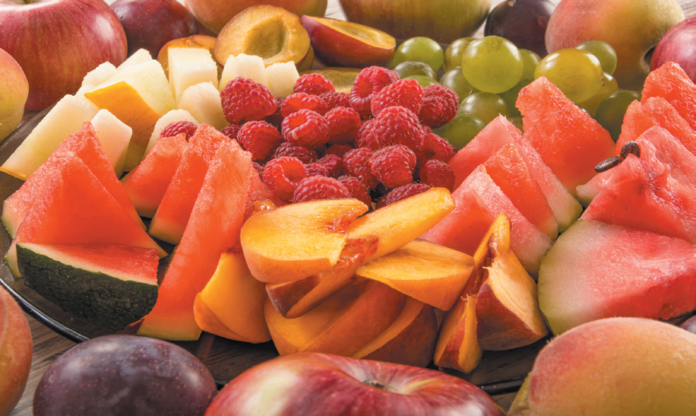Some fruits are touted as “superfoods,” and others maligned as unhealthy. The simple truth is that all fruits are health-promoting choices. Unfortunately, the majority of Americans do not eat the recommended daily amount of fruit (the equivalent of about two cups of fruit a day). Putting to rest some common misconceptions can help shift your focus from, “which fruits are the healthiest,” to, “how can I fit more fruits into my diet?”
Myth #1: Fresh, organic fruits are healthiest.
Fresh, frozen, dried, and even canned (in 100% juice) fruits are all good choices, whether they are organic or conventional. They all provide nutrients that are important for health, like fiber, potassium, and health-promoting phytochemicals such as flavonoids. Fresh fruits are a great choice, but frozen, canned, and dried fruits have a longer shelf life, are available year-round, and can be more cost-effective than fresh, which makes them an easy way to increase amounts and variety. Although fresh fruits are undoubtedly nutrient-rich, they are often picked before they are fully ripe and are susceptible to small nutrient loss during shipping and time spent on the produce aisle shelf. Frozen, canned, and dried fruits are allowed to reach peak ripeness (and, therefore, peak nutrient content) and are typically processed soon after harvesting, so nutrient loss is very small (except vitamin C, which is lost in dried and freeze-dried fruit).
When choosing canned fruit, stick to varieties packed in 100% fruit juice. With dried fruits, watch out for added sugars, and be mindful of serving size to avoid overconsumption (one palmful of raisins could equal a very large bunch of grapes).
Organic fruits are grown using fewer pesticides, but there is no evidence that they are nutritionally superior to conventionally grown fruits. Scrub or thoroughly rinse conventional fruits to remove most pesticides.
Myth-busting advice: Eat the fruits you like in a form that is readily available and you enjoy! Keep a variety of fruits in many forms (fresh, frozen, canned, and dried) on hand, and incorporate them into your eating pattern throughout the day. Read labels to be sure there is no added sugar. Be creative— try sliced strawberries in a garden salad or frozen blueberries in your oatmeal.
Myth #2: Fruit juice is just as beneficial as whole fruit.
About one-third of the fruits we consume in the U.S. are in the form of fruit juice. Traditionally, one eight-ounce cup of 100 percent fruit juice counts as one serving of fruit. For many nutrients, 100 percent fruit juices are comparable to whole fruit, but juice lacks dietary fiber (and may fall short on phytochemicals found in edible skins). Without fiber, the sugar in fruit juice is more quickly absorbed by the body, which can cause spikes in blood sugar and increase risk for fatty liver. In addition, liquids tend to be less satisfying than solids, making overdoing it more likely. So, while occasional 100 percent fruit juice is better than no fruit at all, whole fruit delivers a complete package, as nature intended.
Myth-busting advice: Be sure to check labels so you know you’re purchasing only 100 percent juice (many products labeled ‘fruit drink’ contain added sugars and colors). Aim for no more than one glass of 100 percent fruit juice per day and choose whole fruit over fruit juice when possible.
Myth #3: Some fruits should be avoided because they are high in sugar.
Certain fruits, like bananas, grapes, and figs, have developed a bad reputation because they are higher in sugar relative to other common fruits. The fact is, for healthy individuals, the amount of sugar in reasonable portions of any fruit should not be a problem. Even people with diabetes will not necessarily see a blood sugar spike from consuming a usual portion of sweet fruit. “In long-term studies, all types of fruits have been linked to lower risk of weight gain and type 2 diabetes,” says Dariush Mozaffarian, MD, DrPH, dean of the Friedman School of Nutrition Science and Policy and editor-in-chief of Tufts Health & Nutrition Letter. “The benefits of the vitamins, fiber, and phytonutrients outweigh any concerns about sugar.”
Keep in mind that any fruit has less sugar than a single serving of most cookies. Additionally, unlike cookies, even higher-sugar fruit contains fiber, which slows the release of sugar into the bloodstream.
Myth-busting advice: Don’t worry about the natural sugars found in a usual serving of whole fruit. The amount of sugar in any fruit is still less than the sugar in sweets, and less than the combined starch and sugar in many alternative “healthy” snacks like energy or snack bars. Whole fruit is naturally packaged with fiber, nutrients, and plant compounds that may contribute to many health benefits. So enjoy all kinds of fruits in place of less healthy foods without fear!
- Eat Fruit. Keep a variety of fruit, in all forms, readily available and visible. Fresh, frozen, canned, and dried fruits are all good choices.
- Choose Fruit Over Juice. 100 percent fruit juice is fine to consume once per day, but whole fruit contains fiber and intact cell structure, which slows digestion and helps keep blood sugar even.
- Go for Natural Sugar. Even fruits that are higher in natural sugar still have less sugar and more nutrients than most packaged sweet or snack alternatives.
- Mix and Match. Mix your fruit with salads, nuts, seeds, nut butters, or yogurt to add health benefits and slow digestion even further.
























